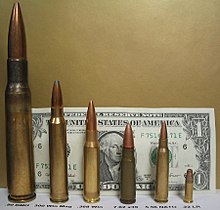ammunition

The term ammunition (abbreviated: Mun. ) Is usually used in connection with a weapon , usually a long-range or firearm , more rarely a tool . In both cases, the term denotes parts that are not permanently connected to the weapon or tool and are usually reloadable and represent the actual functional units. They often only develop their effect at a considerable distance from the weapon, but at least outside the weapon or tool. The weapon or tool can only be viewed as equipment with the help of which the ammunition can be used as intended. In some cases, however, ammunition can also be a weapon itself.
Ammunition is often defined as containing explosives . Therefore, arrows and bolts and the like are separated from the term.
Definition of weapons law (Germany)
According to the German Weapons Act, ammunition and projectiles are:
- Ammunition is intended for use in firearms
- Cartridge ammunition (cases with charges containing a projectile and self-propelled projectiles),
- Cartridge ammunition (cases with charges that do not contain a projectile),
- caseless ammunition (charge with or without projectile, whereby the propellant charge has a shape adapted to the internal dimensions of a firearm or an object according to subsection 1 no.1.2),
- pyrotechnic ammunition (these are objects that contain projectiles with explosive substances or mixtures of substances [pyrotechnic charges] that produce light, sound, smoke, fog, heating, pressure or movement effects and do not develop a specific penetration force in the target); which also includes
- pyrotechnic cartridge ammunition (cartridge ammunition in which the projectile contains a pyrotechnic charge),
- unpatronized pyrotechnic ammunition (projectiles containing a pyrotechnic charge),
- pyrotechnic ammunition firmly connected to the drive device.
- Cargoes are the main energy carriers that are entered in bulk in ammunition or as prefabricated cargo or in bulk in weapons according to subsection 1 no. 1.1 or objects under subsection 1 no. 1.2.1 and
- to drive projectiles or active substances or
- for generating sound or light pulses
are intended, as well as ignition charges that are used directly to propel projectiles.
- Projectiles within the meaning of this law are intended as weapons or for firearms
- solid bodies,
- gaseous, liquid or solid substances in enclosures
Military definition
Ammunition is defined as items and components that
- Contain explosives or consist of explosives,
- Contain explosives and other dangerous substances (e.g. fire, smoke, irritant or smoke substances),
- Do not contain an explosive, but contain or consist of other dangerous substances and are used as a means of combat, representation, observation, marking or signaling,
- Do not contain or consist of explosives or other dangerous substances, but are fired or used from / with weapons.
Basic types
There are several basic types:
- Cartridge ammunition usually consists of a cartridge case, a projectile , a propellant charge and an ignition charge . These components are combined in one cartridge . A special type is the caseless cartridge .
- Cartridge ammunition , the projectile and the sleeve for the propellant are separated.
- Warheads or warheads
- Hand grenades
- Mines
- Bombs
- Torpedoes
- Rockets , including propellants
- Pyrotechnic ammunition is cartridge ammunition in which the projectile contains a pyrotechnic charge, for example tracer ammunition , flare grenades , smoke grenades .
- Practice ammunition
Ordnance disposal
Used ammunition and ordnance that did not take effect (so-called duds ) can be stored in the ground for long periods of time. Due to the possibility of an explosion, for example, to the touch, but also a self-detonation and by releasing their partially toxic ingredients, they pose a danger to humans and the environment. For the neutralization (also ordnance disposal ) is the bomb disposal or munitions recovery service used.
See also
- Readiness ammunition
- Artillery ammunition
- Precision-guided ammunition
- Grenade ammunition : grenade , shrapnel
Web links
Individual evidence
- ↑ Ammunition: History of Building Types ( Memento from February 26, 2006 in the Internet Archive )
- ↑ WaffG Annex 1 (to Section 1, Paragraph 4)
- ^ Central service regulation of the Bundeswehr - ZDv 30/41 Terms of logistics and armament ; As of 04/2013